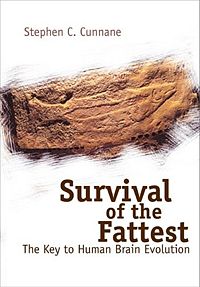Survival of the Fattest: Difference between revisions
imported>Brian R. Head No edit summary |
imported>Brian R. Head No edit summary |
||
| Line 17: | Line 17: | ||
==Synopsis== | ==Synopsis== | ||
===The Human Brain=== | ===The Human Brain=== | ||
Cunnane begins by explaining the similarities of all animal brains. [[Homeobox|Hox]] genes control the traits of brains for almost all animal species. Similar to all primates, humans don’t show a specific genetic advantage for brain growth while in the early stages of embryonic development. <ref name=Cunnane 2005.>Cunnane | Cunnane begins by explaining the similarities of all animal brains. [[Homeobox|Hox]] genes control the traits of brains for almost all animal species. Similar to all primates, humans don’t show a specific genetic advantage for brain growth while in the early stages of embryonic development. <ref name=Cunnane 2005.>Cunnane SC. Survival of the Fattest: The Key To Human Brain Evolution. World Scientific, Singapore, 2005.</ref> He describes the uniqueness of the human brain as having low resistance to damage, low functionality at birth, yet being incredibly vulnerable and needing a constant energy supply to develop normally. The newborn infant brain uses about 74% of the energy consumed by the entire body. <ref name=Holliday 1971.> Holliday M. Metabolic rate and organ size during growth from infancy to maturity during late gestation and early infancy. ''Pediatrics'' 47, 169-172, 1971.</ref> A basic question, central to any [[hominid]] brain evolutionary theory, is posed: Where could ancient hominids obtain the high metabolic energy that is needed for brain development? | ||
Cunnane describes a phenomenon called ''critical periods'' of progressive neurological developmental periods. If any of these ''critical periods'' are interfered with, the developing brain will become vulnerable to all kinds of Brain Damage. The brain needs a constant supply of brain selective nutrients to develop normally. These ''critical periods'' happen before the baby is born as well as during the first years of infancy. Ultimatley, infants who have a poor diet are extremely vulnerable to have permanent mental retardation. | |||
The human brain uses primarily [[glucose]] to function. <ref name=Cunnane 2005./> However, the brain needs ''backup'' fuel requirements called [[Ketone|Ketone Bodies]] that form during fatty acid oxidation. Ketones are important during periods of starvation when glucose levels in the blood drop. Cunnane hypothesizes that in order for the human brain to get larger, humans had to evolve a larger extent to make ketones that come from greater fatty acid reserves—e.g. fatter babies. | |||
==Brain Selective Nutrients== | ==Brain Selective Nutrients== | ||
Revision as of 18:09, 16 March 2008
Articles that lack this notice, including many Eduzendium ones, welcome your collaboration! |
THIS IS AN ACITVE STUDENT PROJECT THROUGH A SPECIAL UNIVERSITY OF COLORADO PROJECT PLEASE REFRAIN FROM EDITING. THANK YOU
Survival of the Fattest: The Key to Human Brain Evolution was written by Stephen C. Cunnane. The book outlines why fat babies are important to human brain evolution and the ecological circumstances that allowed for fat babies to evolve. Cunnane details the specific nutrients that are important for human brain growth and function and explains the ways in which they work. Cunnane also presents a theory called the Shore-Based Scenario to explain where ancient hominids obtained these nutrients. The book has implications for many fields such as: Neurophysiology, Biological Anthroplogy, Paleoanthropology, Paleoecology.
Synopsis
The Human Brain
Cunnane begins by explaining the similarities of all animal brains. Hox genes control the traits of brains for almost all animal species. Similar to all primates, humans don’t show a specific genetic advantage for brain growth while in the early stages of embryonic development. Cite error: Invalid <ref> tag; invalid names, e.g. too many He describes the uniqueness of the human brain as having low resistance to damage, low functionality at birth, yet being incredibly vulnerable and needing a constant energy supply to develop normally. The newborn infant brain uses about 74% of the energy consumed by the entire body. Cite error: Invalid <ref> tag; invalid names, e.g. too many A basic question, central to any hominid brain evolutionary theory, is posed: Where could ancient hominids obtain the high metabolic energy that is needed for brain development?
Cunnane describes a phenomenon called critical periods of progressive neurological developmental periods. If any of these critical periods are interfered with, the developing brain will become vulnerable to all kinds of Brain Damage. The brain needs a constant supply of brain selective nutrients to develop normally. These critical periods happen before the baby is born as well as during the first years of infancy. Ultimatley, infants who have a poor diet are extremely vulnerable to have permanent mental retardation.
The human brain uses primarily glucose to function. Cite error: Invalid <ref> tag; invalid names, e.g. too many However, the brain needs backup fuel requirements called Ketone Bodies that form during fatty acid oxidation. Ketones are important during periods of starvation when glucose levels in the blood drop. Cunnane hypothesizes that in order for the human brain to get larger, humans had to evolve a larger extent to make ketones that come from greater fatty acid reserves—e.g. fatter babies.
